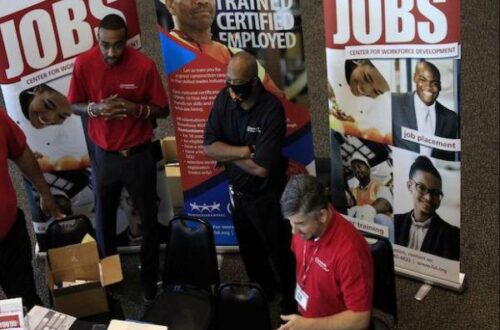
The worker deficiency could prompt a downturn one year from now
Throughout the course of recent months, US purchaser costs rose by 7.5%, the most noteworthy rate in almost 40 years. More awful, expansion is giving no indications of easing back.
While we presumably won’t see a slump this year, a downturn one year from now is turning out to be progressively logical, for various reasons.
Organizations across the United States can’t track down an adequate number of representatives. One quick arrangement is straightforward: Bring in more unfamiliar laborers.
The US needs about 10 million individuals, including low-pay and high-talented laborers, to fill employment opportunities across the country – and just 8.4 million Americans are effectively looking for work.
Furthermore notwithstanding employment opportunities hitting memorable highs in July and broadened joblessness benefits finishing off with September, Americans aren’t getting back to work, particularly in low-wage businesses. Simultaneously, laborers are leaving in record numbers. Also however purchaser spending has flooded for this present year, organizations don’t have individuals to fulfill need – to adapt, a few organizations are raising their costs. Store network bottlenecks are in any event, taking steps to destroy Christmas.
To begin with, there is regularly a slack between a loan fee climb and its monetary impact. A few assessments propose that it requires one to two years for the effect of financial arrangement to top. While the Fed is probably going to begin bringing rates up in March, the greater part of its climbs are probably going to happen in the final part of this current year. That implies that the negative financial effect will be a lot more grounded in 2023 than in 2022.
Second, the in-person benefits area, hard-hit by the pandemic, is probably going to proceed with its quick development through 2022. Spending on things like cafés, lodgings, amusement, public transportation, stylists, exercise centers and numerous other utilization classifications may not completely recuperate in 2022, however the subsiding apprehension of the pandemic will spike solid development.
At the point when the economy is delicate, there’s an intuition to close lines to safeguard American specialists. What’s very more, that is what the US has done during the pandemic, basically stopping lawful movement and shutting the southern line to travelers and shelter searchers. In an ordinary year, the US invites approximately 1 million settlers, and around 3/4 of them wind up taking an interest in the workforce. In 2020, that number dropped to around 263,000.
By and large, monetary examination has shown that the appearance of low-wage unfamiliar specialists adversely affects local conceived laborers’ wages or work. What’s more under the current conditions, inviting all the more low-wage unfamiliar specialists could address intense work deficiencies in specific businesses, assisting hard-hit region of the country with recuperating while at the same time fighting off higher expansion.
That might seem like uplifting news, yet the greater part of the positive effect of the recuperation of in-person administrations will trail off by mid 2023. Spending on these administrations will have standardized by then, at that point, similarly as the higher financing costs pack their most grounded clobber.
Likewise, a solid recuperation in-person benefits this year will likewise fuel the interest for laborers, which we at the Burning Glass Institute hope to develop by around 4 million during 2022. We anticipate that that should bring down the joblessness rate from 4% now to beneath 3% in mid 2023. This low joblessness will support wage pressures, which will keep on taking care of expansion. In the final part of 2022, the Federal Reserve might see that as, regardless of its initial loan cost climbs, expansion isn’t descending a lot. The Fed’s well deserved validity on containing expansion will dissolve. With strain to contain expansion mounting, it might raise loan fees quicker than it at present predicts, and further push down financial development in 2023.
The ventures right now confronting the most terrible work deficiencies incorporate development; transportation and warehousing; convenience and friendliness; and individual administrations organizations like salons, cleaners, fix administrations, and funeral directors. Each of the four businesses had expansions in work postings of in excess of 65% while contrasting the long stretches of May with July 2019 to a similar time-frame in 2021, as indicated by an investigation led for Vox by the supportive of migration New American Economy think tank. Foreigners make up no less than 20% of the labor force in those enterprises.
A long way from retreating with the pandemic, the work deficiency will turn into the new typical. Pandemic-related factors, for example, the drop in movement, exits from the workforce and lower workforce investment among working-age individuals joined with long-running hidden patterns have profoundly decreased the US work supply. In 2020, for instance, the working-age populace of the US began contracting, driven by longer-term factors like the gen X-er age maturing and resigning. Likewise, ladies’ workforce investment rate quit developing, while that of men and youthful grown-ups have declined significantly even before the pandemic.
Authoritatively, outsiders represent almost a fourth of development laborers, however that is reasonable an undercount on the grounds that numerous development laborers are recruited casually and don’t show up in standard financial insights. All things considered, 1.6 billion of them overall saw an expected 62 percent decrease in pay during the primary months of the emergency.
The truth of the matter is that work deficiencies are not going anyplace. Could the Fed’s loan fee climbs be to the point of setting off a 2023 downturn? That is not yet clear, however it is a genuine chance. What is sure is that the waning work supply is turning into a genuine imperative on US financial development.
“The potential gain of the lack is that you’re seeing wages go up, which is astonishing for American laborers,” said Jeremy Robbins, leader head of New American Economy. “The disadvantage is in the event that you can’t get laborers to come fill these jobs, you can’t run organizations.”
For some individuals who worked unwanted or low-paying position before the pandemic, the economy’s appearing wealth of business choices and dealing influence is an improvement in conditions. Yet, financial analysts stress the specialist lack is uncommon to such an extent that it will compromise monetary development in general and maybe lead to higher expansion.
Lucas Jacob is an english poet, playwriter and actor. He has written many poems and short stories. He completed MBA in finance. He has worked for a reputed bank as a manager. Greg has found his passion to write and express, that is why he has decided to become an author.
Disclaimer: The views, suggestions, and opinions expressed here are the sole responsibility of the experts. No STOCK INVESTS journalist was involved in the writing and production of this article.





